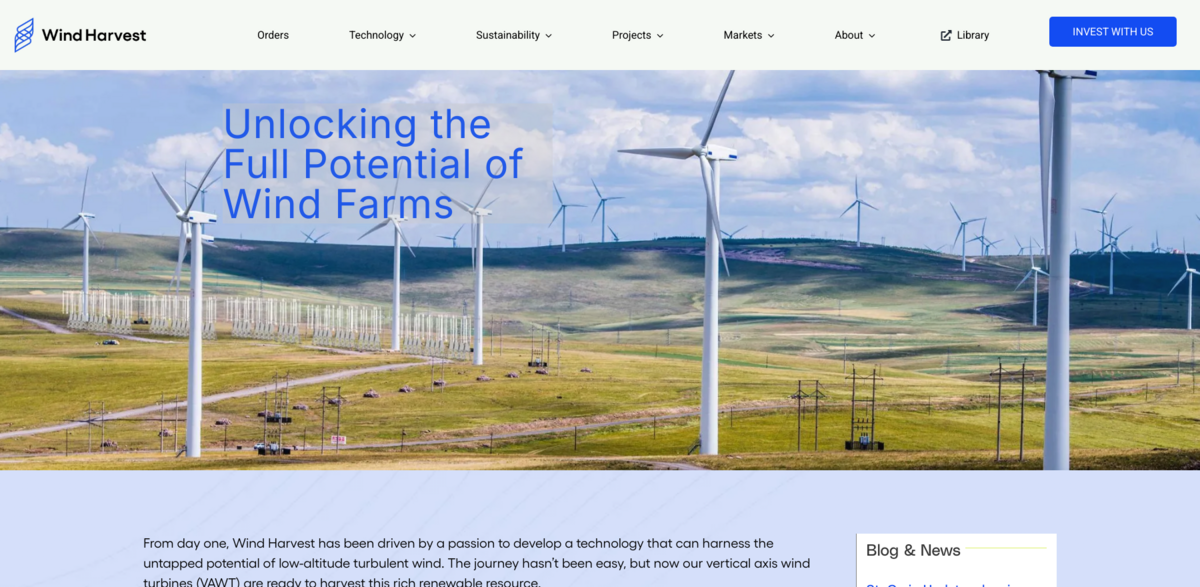What is the Wind Harvest Project?
Wind Harvest is all about unlocking the full potential of wind farms by tapping into a resource often overlooked—low-altitude turbulent wind. Unlike traditional horizontal axis wind turbines (HAWTs), which just don’t fit every site, Wind Harvest’s vertical axis wind turbines (VAWTs) are designed to thrive where others can’t. Think narrow roads, limited port access, visual restrictions, and even wildlife concerns. These turbines are shorter, tougher, and built for challenging conditions, making them perfect for places where tall turbines simply won’t work. After years of persistence, the Wind Harvester® 4.0 turbine is now on the brink of certification and sales, ready to power a more sustainable future.
Main Benefits of Wind Harvest’s VAWTs
These turbines bring a fresh approach to wind energy, with some impressive advantages:
- Compact size: Standing 57-90 feet tall—shorter than most palm trees—reducing visual and radar impacts.
- Harvest turbulent wind closer to the ground, opening up new wind resources HAWTs can’t reach.
- Can be installed closer together, even on tricky sites like ridge lines with telecom towers, airports, and air force bases.
- Work beneath existing HAWTs in wind farms, boosting overall efficiency through synergy.
- Pairs of VAWTs use the Coupled Vortex Effect to increase energy output.
- Robust blade design with vertically aligned drive shafts and multiple blade supports to handle turbulent winds without shaking.
- Lower blade-tip speeds and 3D blade paths make them more visible to birds and bats, reducing wildlife harm.
- Projected 70+ year lifespan with regular maintenance, thanks to patented innovations like hinged connections and a hexagonal mast.
- Synergistic array performance: closely spaced turbines (within one meter) can boost annual energy production by 15% or more.
- Lower total cost per kWh in many locations compared to new wind and solar farms.
Innovative Design and Durability
Wind Harvesters are compact, mid-sized H-type VAWTs featuring extruded aircraft aluminum blades and an all-galvanized steel rotor and tower. Their two-arm-per-blade configuration and vertical struts contribute to a sturdy, long-lasting machine. The design is simple yet robust, with patented features that promise a fatigue life of over 70 years. This durability means these turbines can endure harsh conditions and keep producing clean energy for decades, making them a reliable choice for utility-scale projects.
Installation and Manufacturing Approach
One of the clever aspects of Wind Harvest’s approach is how the turbines are assembled. Most of the components, including the lattice tower, are put together in a temporary facility near the installation site. This setup allows suppliers to ship parts efficiently, while local labor is hired and trained to handle assembly. Once ready, the turbines are transported on flatbed trucks and lifted into place with truck-mounted cranes. This method simplifies logistics and supports local economies, all while ensuring quality and precision in the build process.
Market Potential and Applications
The first market for Wind Harvesters is distributed energy projects where traditional tall turbines just won’t cut it. Over time, their biggest market will be new and existing wind farms looking to boost capacity factors and overall efficiency. These turbines are especially suited for properties with strong mid-level wind speeds and high energy costs. Plus, their wildlife-friendly, fully recyclable design means they reduce environmental impacts and require less land over their long lifespan. It’s a win-win for developers and the planet.
Project Impact on Sustainable Development Goals (SDGs)
- SDG 7: Affordable and Clean Energy – by providing innovative, efficient wind energy solutions.
- SDG 9: Industry, Innovation, and Infrastructure – through patented technology and new manufacturing methods.
- SDG 11: Sustainable Cities and Communities – by enabling wind energy in locations unsuitable for traditional turbines.
- SDG 13: Climate Action – reducing reliance on fossil fuels and lowering carbon emissions.
- SDG 15: Life on Land – minimizing harm to wildlife with bird- and bat-friendly turbine designs.
Certification and Future Outlook
Wind Harvest is moving forward with third-party international certification for its Wind Harvester 4.0 turbines, with testing underway at the UL Advanced Wind Turbine Testing Facility in Texas. This certification will pave the way for full commercialization and sales. The turbines are sold in 100-150 kilowatt pairs, arranged closely to maximize energy output with minimal impact. With orders already being taken and installations planned for 2026, Wind Harvest is poised to make a real difference in the renewable energy landscape—bringing compact, durable, and efficient wind power to places that need it most.





















